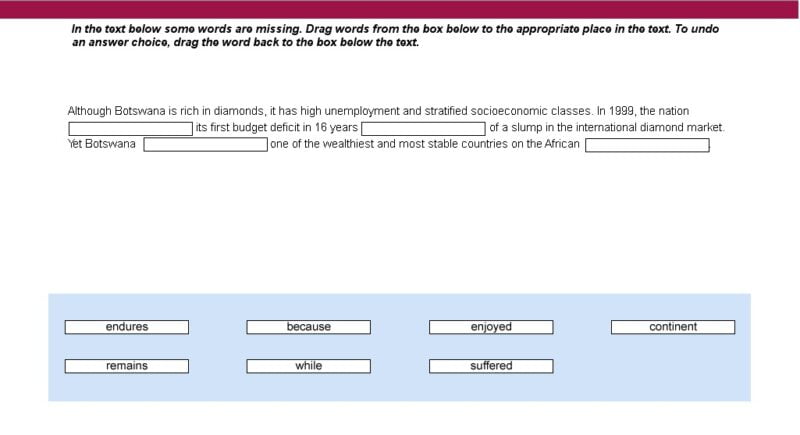
The Pearson Test of English (PTE) Academic is a widely recognized English proficiency test designed to assess the language skills of non-native speakers. One of the critical components of the PTE test is the Reading section, which evaluates your ability to understand written English. Among the various question types in this section, Reading: Fill in the Blanks questions are particularly important. They test your comprehension, vocabulary, and ability to contextualize information.
In this blog post, we’ll dive deep into Reading: Fill in the Blanks questions in the PTE test, exploring their format, and sharing effective tips and strategies to help you ace them. Let’s embark on this journey together, and by the end, you’ll be well-equipped to tackle these questions with confidence.
Understanding Fill in the Blanks Questions
Reading: Fill in the Blanks type requires you to drag and drop words into blanks in a passage. There are 4 to 5 questions in a test.
The question assesses your ability to understand the context of a passage and choose the most appropriate words to complete it. The key to success in these questions lies in your vocabulary knowledge, grammatical understanding, and contextual awareness.

Tips and Strategies for Fill in the Blanks Questions
1. Read the Entire Passage First
Before you start filling in the blanks, read the entire passage carefully. This will give you a general idea of the topic and the context. Understanding the overall meaning of the passage helps you choose words that fit logically and cohesively.
2. Identify Clues Around the Blanks
Pay close attention to the words and phrases around the blanks. These can provide valuable clues about the correct answers. Look for:
- Collocations: Words that commonly go together. For example, “make a decision” is a common collocation.
- Synonyms and Antonyms: Words that have similar or opposite meanings. These can help you understand the context better.
- Grammar and Sentence Structure: Ensure that the word you choose fits grammatically with the rest of the sentence.
3. Eliminate Incorrect Options
For Reading and Writing: Fill in the Blanks questions, you have multiple choices for each blank. Use the process of elimination to narrow down the options. Discard any words that do not fit grammatically or contextually.
4. Use Your Vocabulary Knowledge
A strong vocabulary is essential for Fill in the Blanks questions. Regularly practice and expand your vocabulary by reading a variety of texts, such as books, newspapers, and academic articles. Familiarize yourself with synonyms, antonyms, and collocations.
5. Practice Contextual Understanding
The ability to understand the context of a passage is crucial. Practice by reading different types of texts and summarizing their main ideas. This will help you get better at identifying the overall meaning and selecting words that fit logically.
6. Check for Consistency
Once you have filled in all the blanks, read the passage again to ensure that it makes sense as a whole. Check for consistency in terms of grammar, meaning, and flow. Make sure that all the words fit together harmoniously.
7. Manage Your Time Effectively
Time management is crucial in the PTE test. Allocate a specific amount of time to each question and stick to it. If you are unsure about a particular blank, make an educated guess and move on. You can always come back to it if you have time left at the end.
8. Use Practice Materials
Regular practice with PTE practice materials is essential for improving your skills. Use official PTE practice tests and other reliable resources to familiarize yourself with the question formats and practice under timed conditions.
You may like:

Example and Explanation
Let’s look at an example to illustrate how to approach Fill in the Blanks questions.
Example Passage
Reading: Fill in the Blanks
Passage:
Climate change is one of the most significant challenges facing our planet today. It has far-reaching impacts on the environment, human health, and economies. Scientists agree that immediate action is necessary to mitigate the __________ of climate change. Renewable energy sources, such as solar and wind power, play a crucial role in reducing greenhouse gas emissions. Additionally, __________ energy consumption through improved efficiency and conservation measures can also make a significant difference. Public awareness and __________ are essential to drive policy changes and promote sustainable practices. By working together, we can create a more sustainable future for generations to come.
Options:
| decreasing | consequences | engagement |
Analysis and Solution
Blank 1:
- The passage discusses the importance of immediate action to mitigate climate change. The word “mitigate” means to make less severe. Therefore, we need a word that relates to the negative effects of climate change. Therefore, the option “consequences” fits the context of reducing negative effects.
Blank 2:
- The sentence talks about the role of renewable energy and mentions improved efficiency and conservation measures. Hence, “decreasing” fits the context of reducing energy consumption.
Blank 3:
- The sentence emphasizes the importance of public involvement to drive policy changes and promote sustainable practices. Here, the word “engagement” fits the context of active participation.
Completed Passage:
Climate change is one of the most significant challenges facing our planet today. It has far-reaching impacts on the environment, human health, and economies. Scientists agree that immediate action is necessary to mitigate the consequences of climate change. Renewable energy sources, such as solar and wind power, play a crucial role in reducing greenhouse gas emissions. Additionally, decreasing energy consumption through improved efficiency and conservation measures can also make a significant difference. Public awareness and engagement are essential to drive policy changes and promote sustainable practices. By working together, we can create a more sustainable future for generations to come.
Conclusion
Fill in the Blanks questions in the PTE Reading section may seem challenging at first, but with the right strategies and practice, you can master them. Remember to read the entire passage, identify contextual clues, eliminate incorrect options, and use your vocabulary knowledge effectively. Practice regularly with PTE materials to build your skills and confidence.
By following these tips and strategies, you’ll be well-prepared to tackle Fill in the Blanks questions and achieve a high score in the PTE Reading section.
Gaurav Thapa is an experienced instructor of English as a Foreign Language. He has eight years of experience teaching IELTS and PTE.